Excerpt from ‘The history of Vylbrand, from Nym to Limsa Lominsa’ by Archon Niniri Niri.
The Wanderer’s Palace is one of the finest relics left behind from the Fifth Astral Era. The structure was a temple or similarly sacred structure dedicated to Oschon the Wanderer. In modern Eorzea Oschon is regarded as a deity of the mountains, wanderers and vagrants, and is one of the deities associated with the element of wind alongside Llymlaen the Navigator, patron deity of Limsa Lominsa. He is represented by a walking cane and as a youthful ranger bearing a bow, and is regarded as friend to Halone the Fury, patron of Ishgard and brother of Nald’thal the Traders, twin patrons of Ul’dah. His lover is Menphina the Lover. Back in the Fifth Astral Era he was also patron of the city-state of Nym, rulers of coastal Vylbrand.
Nym was born in the Fifth Astral Era, also known as the Age of Enlightenment, coming to maturity along the western and southern coasts of Vylbrand after a founding by Lalafellin merchant tribes from the Southern Islands. Nym was a comparatively small city state that survived via its mercantile skill as well as a force of elite marauders paired with the finest arcanists in tacticians in the realm, forming a military force known as the Royal Nymian Marines. These warriors proved capable, despite their meagre numbers, of stymying even Mhach’s most powerful waves of Voidsent invasions from across the ocean. Unlike the modern state of Limsa Lominsa, Nym enjoyed cordial relationships with their kobold neighbours inland, in part because of the Nymians worshipped Oschon, a deity of mountains, and the Kobolds worshipped their home mountain, O’ghomoro, and the deity Titan, as their own patrons. This allowed the two peoples to respect each other’s deities and perhaps even regard them as kin or aspects of each other.
Unfortunately Mhach was nothing if not cunning and managed to make the Nymians carry an urn of their artifice into the city, which contained a voidsent of the middling 6th rung, Bitoso. This creature began to afflict the Nymian populace with its corruption, tainting them and maiming them horribly, causing their bodies to shrivel, their flesh discolor and their ears and nose to melt off. Unable to contain the plague no matter what they tried, the plague itself and the hysteria and paranoia caused by it weakened Nym immensely. As the War of the Magi continued the Sixth Umbral Calamity, or the Calamity of Water, began to emerge and Aldenard rapidly began to flood. A ceasefire was declared, and Nym fielded its navy before its capital in an exercise known as Operation Maelstrom. Their ships traced arcane equations in the ocean, erecting a colossal aetheric wall to resist the floodwaters. While this occurred the citizens of Nym fled inland, to shelter in the mountains and highlands of central Vylbrand. The sacrifice of the Royal Marines succeeded, holding back the initial wave of the Calamity but allowing successive, lesser ones through. This saved the civilians of Nym, although it reduced their homes to ruin and made the site of their city impossible to resettle by reducing it to tattered coral reefs. As with all the survivors of the Calamity, they abandoned their past to settle small hamlets or leave their homeland entirely, traumatized to the past to such an extent as they were.
The Palace was entirely hidden after the flood of the Calamity, sunken under a massive lake known in modern times as Bronze Lake. It would later be uncovered an entire age later, in the Seventh Umbral Calamity when the fel assault of the elder primal Bahamut struck Vylbrand, opening the lake to Kobold tunnels beneath it and draining it. The Palace was immediately recognized as immensely beautiful, but a darker secret lurked beneath the surface and was uncovered when the adventurers of the realm dove within. They found the survivors of Nym inside, mutated horribly by the dark influences of the voidsent servant of Mhach, Bitoso, who had originated a grim plague that turned the populace into creatures known as tonberries. It was revealed that the Nymians had turned to their sacred palace in a time of immense need just prior to the Calamity, trapping the tonberries within in a kind of quarantine enforced by a ritual conducted by the mages of Nym, who flooded the area around the Palace and created the Bronze Lake to seal their shame beneath the surface.
The Point of Peregrination
Any expedition into the palace begins after a short rowboat ride in a small antechamber, still partially flooded despite the draining of Bronze Lake. The thalassocratic nature of Nym was immediately apparent in the room, with elegant channels that allow waterfalls to flow throughout the palace adorning the walls. Various runic designs decorated the ceiling, likely bearing some significance to Oschon, and the trademark conical pillars of Nym lined the walls. Investigation of the structure has revealed the name of the chamber to be the ‘Point of Peregrination’, which is to say a point at which a long and difficult journey is undertaken. It is unclear if this refers to the pilgrimages that took place through the Palace, or the fate of the tonberries, though it is this scholar’s guess that the former was the intent, with the latter becoming true after the fact.
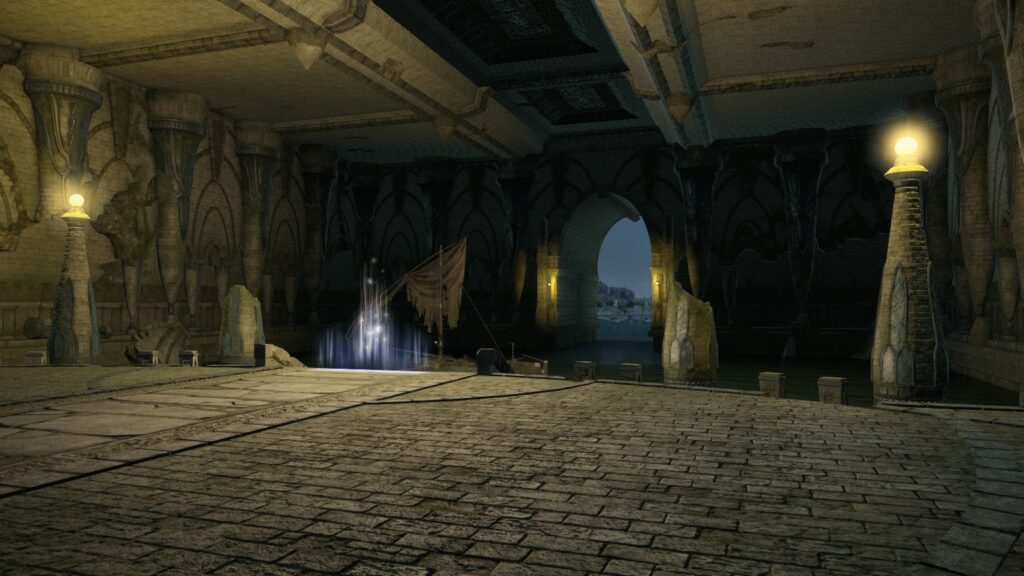
The Silent Garden
A beautiful area now as it must have been in Nym’s prime, the Silent Garden was opened by a raised walkway atop channels of water fed by the same artificial waterfall system as previously described. The central chamber of the Garden’s opening section was decorative by a large symbol of Oschon emblazoned upon the floor. Lush flora, from shrubs to trees, could be found across the Garden, less manicured than those that existed during the Palace’s prime but still rich with natural beauty. Deeper within the area was a divot in the floor within the floor filled with a very shallow layer of water. It is hard to speculate if this was intended to be flooded or dry, but either way some significance could be derived. It may have been used as a pool of water for sacred rites or, if dry, as a place for meetings or prayers. This author believes the latter is more likely, due to Oschon’s relation to wind over water.
Deeper within still was a smaller room centered around a much deeper pool of water beneath a large, ornamental chandelier. A hole in the wall reveals every archaeologist’s dream – a new dimension to a lost civilization. Massive gears and machinery churned within the walls, still functional in modern day through some miracle of engineering. These devices seem to have been how the water channels throughout the palace functioned, driving a circular flow of water. This is a testament to the immense mathematical ability of the scholars and arcanists native to Nym. Past this point some less functional machinery could be found, with gears fallen from the walls, perhaps by the march of age and the pressure of the lake. A cane of Oschon could be found repeated at the back of the chandelier chamber, and the exit of the gardens was a ornate metal door.
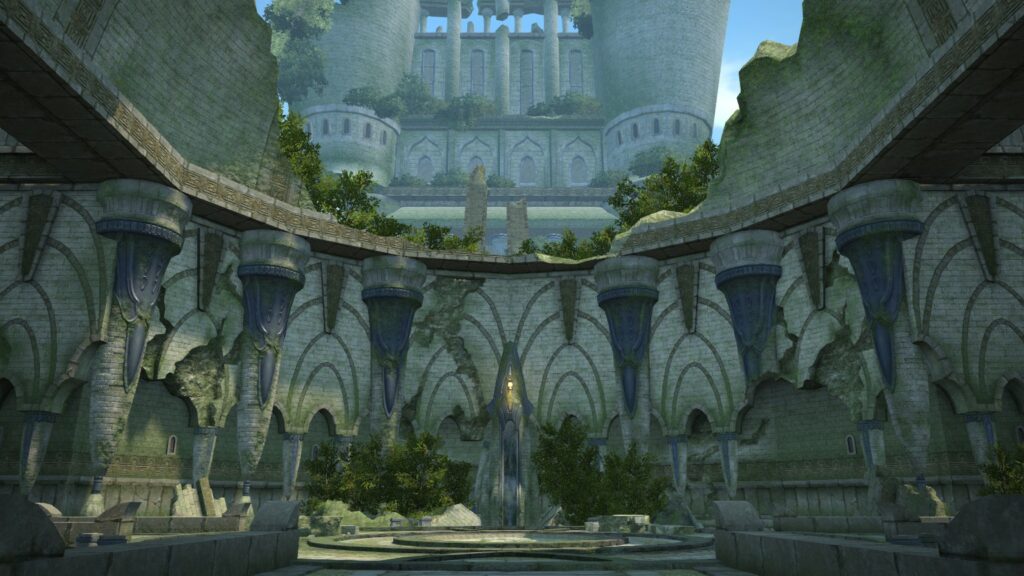
The Still Waters
As if to further evidence the scale and majesty of the Palace, when one leaves the Garden they will arrive before the actual door to the Palace and realize that the halls they had passed through were the mere prelude. The edifice of the Palace was simply enormous, and the faith that Nym held for Oschon was evident in the structure they erected in his name. The entrance to the Palace was a large metallic door operated by an elaborate mechanism, and the Still Waters themselves consisted of a large square pool fed by the lake structured around a large tilted platform. It was difficult to tell if this area was intended to be flooded or not, but one might assume by the recovered name that it was. Either way, the name was clearly intended to convey a sense of tranquility and this might have been a place for contemplation and reflection before carrying on with ones pilgrimage into the Palace.
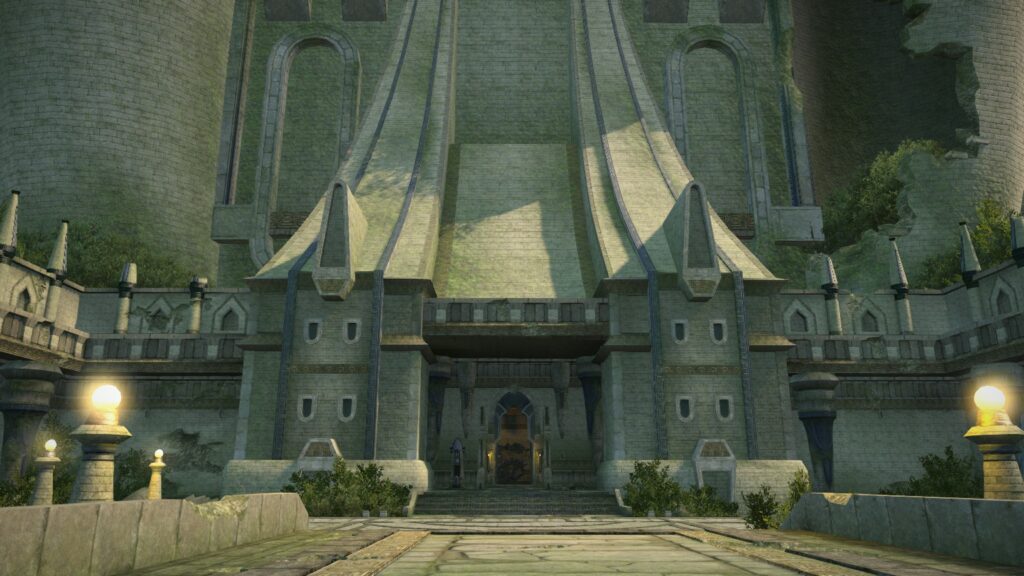
The Long Hall
The connecting sections of the Palace were named the Long Hall according to recovered records, and although they were ornate and various sightings of the Palace’s inner machinery, mostly broken here, were seen within, little distinguished them. Passage through these areas required some repair of the door mechanisms, as they had become rusted and thus barely operational. The structures played fully into the theme of pilgrimage and voyages throughout the Palace, which should not be surprising considering Oschon’s role as the Wanderer and his portfolio of travelers and vagrants. This pilgrimage seems to have replicated a difficult journey, perhaps even an allegory for the passage of one’s life, with various stages represented by the different areas of the Palace.
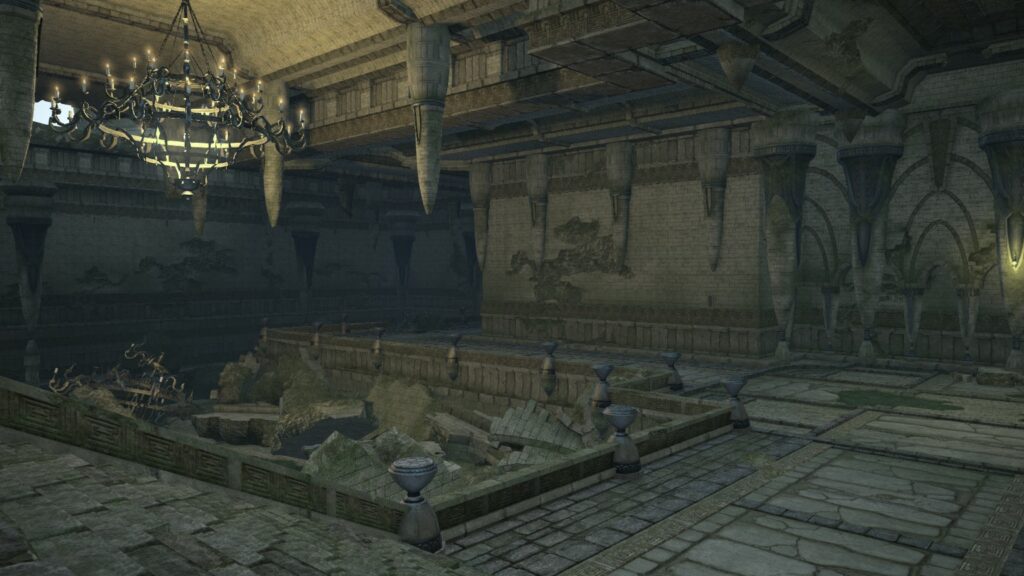
The Endless Rise
Simply enormous, the Endless Rise was composed of a wide square walkway around the sides of a room with a large raised square platform in the center, separated by a colossal drop downwards, presumably leading deep into a massive aquifer or subterranean body of water This room seemed to have been the center for the engineering systems of the Palace, a mighty hydraulic apparatus built around the flow and use of water, lifted in large buckets on moving chains from the depths to the heights of the Palace. This endless mechanical motion is doubtless referenced in the etymology of the room, but if one applies the Palace as a metaphor for a journey then one might consider this room a reference to the struggle and strife of adulthood, constantly striving to survive and to improve one’s station in life.
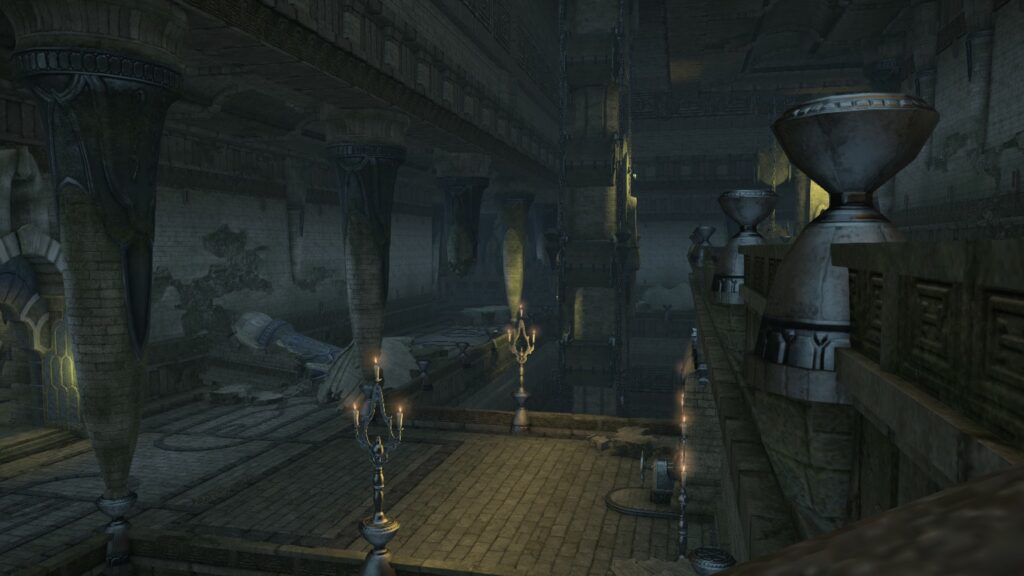
The Final Ease
The chamber past the Endless Rise was the Final Ease, a more modest room framed by two immense water wheels. An ornate framework of stone lay on the floor of this room, flooded in the Palace’s neglect. This chamber’s name was surely a reference to the next step in the journey, a final resting place before one headed onto the Chantry and the zenith of their sacred wandering. One cannot help but speculate that the room grew to adopt a second meaning during the plague however, as a place in which many of those infected died, finally finding peace.
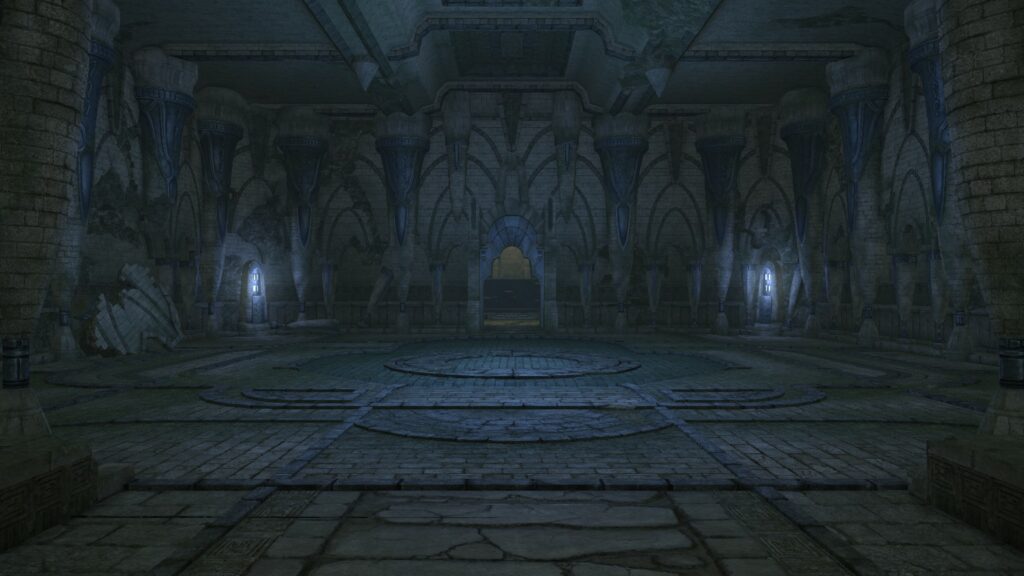
The Chantry
The Palace terminates in a large chamber surrounded by a channel of water and overseen by a huge chandelier. This room was named the Chantry, and thus may be one of two things. Its name may have been drawn generally from the word simply to define the room as a sacred shrine of Oschon. It may also be have been taken more strictly from the word’s definition, which is to say a structure or area built and maintained by a sizeable amount of money donated by an individual in dedication to their soul or the soul of another. In this case it may refer to a ruler, general or particularly notable scholar of Nym or even a saint of Oschon.
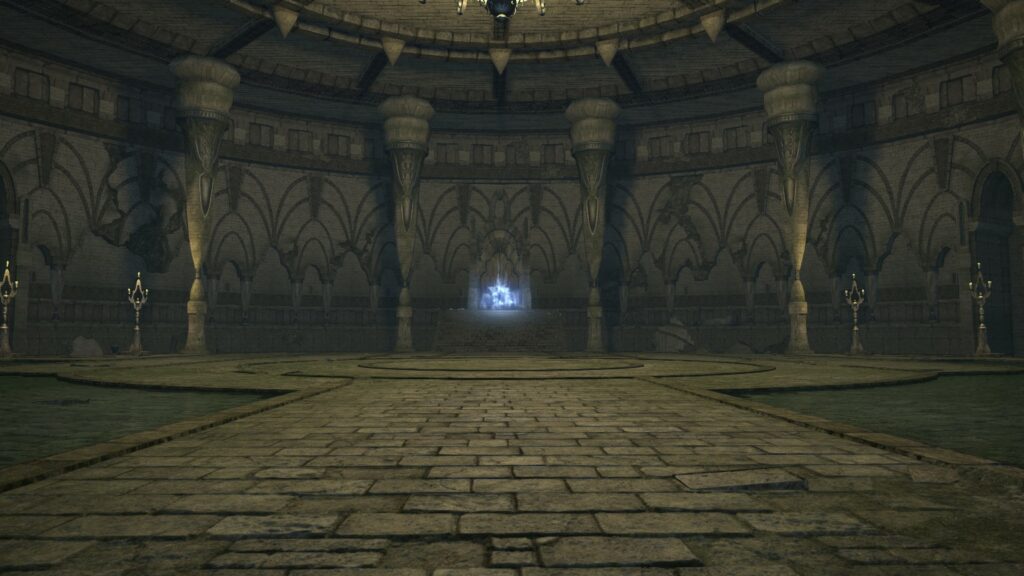




Leave a Reply